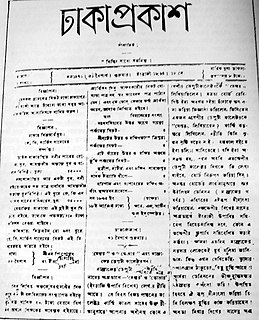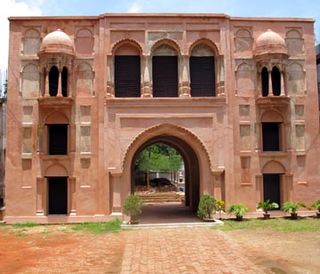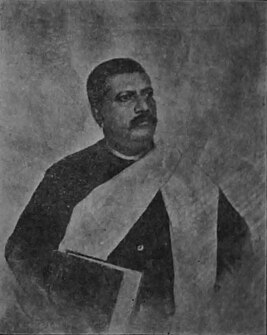Related Research Articles

Dhaka, formerly known as Dacca, is the capital and the largest city of Bangladesh. It is the ninth-largest and the sixth-most densely populated city in the world, with a population of 8.9 million residents within the city limits, and a population of over 21 million residents in the Greater Dhaka Area. Dhaka is the economic, political and cultural center of Bangladesh. It is one of the major cities of South Asia, the largest city in Eastern South Asia and among the Bay of Bengal countries; and one of the largest cities among OIC countries. As part of the Bengal plain, the city is bounded by the Buriganga River, Turag River, Dhaleshwari River and Shitalakshya River. The city is located in an eponymous district and division.

Rao Farman Ali, was a Pakistan Army General and former political figure who is widely accused as a "conspirator" of the civil war in East Pakistan and one of directly responsible of the mass atrocities in East Pakistan.

Dacca or Dhaka is the capital and one of the oldest cities of Bangladesh. The history of Dhaka begins with the existence of urbanised settlements in the area that is now Dhaka dating from the 7th century CE. The city area was ruled by the Buddhist Pala Empire before passing to the control of the Sena dynasty in the 9th century CE. After the Sena dynasty, Dhaka was successively ruled by the Turkic and Afghan governors descending from the Delhi Sultanate before the arrival of the Mughals in 1608. After Mughals, British ruled the region for 200 years until the independence of India. In 1947, Dhaka became the capital of the East Bengal province under the Dominion of Pakistan. After the independence of Bangladesh in 1971, Dhaka became the capital of the new state.

Chawkbazar Shahi Mosque or Chawk Mosque in Dhaka, Bangladesh, is located in the Chowk Bazaar area of the old town of Dhaka, south of the current city centre. The mosque was constructed in 1676 by Subahdar Shaista Khan. The mosque is called Shahi Mosque because it was founded by Subahdar Shayesta Khan. The mosque is built above a raised platform. The three domed mosque above the platform, now transformed into a multi-storied structure was originally a copy of Shaista Khan's another three domed mosque at the Mitford Hospital compound near the Buriganga River. There are some square-shaped rooms maybe built for Imam and for students of the madrasa. Today the original building design has been lost most of its original form through multiple renovations and extensions.

The Armenians in Bangladesh were ethnic Armenians who lived in what is now called Bangladesh. Their numbers have gradually diminished and there is now no Armenians in the country.

Teacher-Student Centre of the University of Dhaka is a building on the Dhaka University campus in Shahbagh, Dhaka, Bangladesh. The Centre was established in 1961 by the Dhaka University as the Division publicAffairs.

Soham Swami was a Hindu guru and yogi from India. Originally named as Shyama Kanta Bandopadhyay, he was the disciple of the Advaita Vedantist Tibbetibaba. Tibbetibaba was a great yogi and guru of India.
It can not be said with certainty where the first printing press was set up in Bangladesh. It is conjectured that the first printing press in Bangladesh was in Rangpur during 1847, about 335 kilometres (208 mi) away from Dhaka. The first printed piece from this printing press was a weekly newspaper named Rangapur Barttabaha in August 1847. In addition the first two Bengali weekly newspapers were from Rangpur. Printing machines took more than sixty years to reach East Bengal or Dhaka from Kolkata. The first English weekly newspaper, The Dacca News, was printed and published from Dhaka in 1856. So, it is assumed that after nine years of Rangpur press, the first printing machine of Dhaka was established and the press was named 'Bangla Press'.
Mill Barrack is a former military barracks situated at Gendaria, Dhaka, Bangladesh, currently occupied by the Range Reserve Force of the Metropolitan Police. After the Indian Rebellion of 1857 it held the forces that had been located at Lalbagh Fort. It held one of two police training schools that were set up in Bengal in 1903, and is now used for training traffic police.

Salimullah Muslim Hall is a residential hall at Dhaka University, named after Nawab Sir Khwaja Salimullah Bahadur. It was inaugurated on 11 August 1931. Among the residential halls of Dhaka University, Salimullah Muslim Hall holds a special status due to its heritage.
Forashganj is a neighborhood in Dhaka, Bangladesh. The name comes from the Bengali word for French which is Forashi and ganj, meaning market-town.
Shaista Khan Mosque is a historically significant architectural monument situated by the Buriganga River at Mitford Area in old Dhaka, Bangladesh. The mosque is an architecture of Mughal period. The mosque was built by Mughal Subahdar of Bengal, Shaista Khan.

Holy Rosary Church is a Roman Catholic church in the Tejgaon area of Dhaka. It is also known as Tejgaon Church and once popularly called the Japmala Queen Church. Under this Catholic church has 17,120 Catholics. Fr. Kamal Andreas Corraya is parish priest of this church and Fr. Mintu Lawrence Palma, Fr. Antony Ripon D' Rozario and Fr. Sony Martin Rodrigues are serving there as assistant parish priest. Each Sunday Catholics gather there for Sunday mass and thousands devotee join there.
The following is a timeline of the history of the city of Dhaka, Bangladesh.
James Fawns Norton Wise was a British civil surgeon of Dhaka in 1860s. He was also a writer.

Dhaka Prakash was the first Bengali language newspaper published in Dhaka, the capital of Bangladesh.
The Bengal Times was a newspaper published from Dhaka. It was the second newspaper of its kind published in 1871. E. C. Kemp was the editor. It was a bi-weekly newspaper published every Sunday and Saturday.

The Naib Nazim of Dhaka, officially the Naib Nazim of Jahangir Nagar, was the chief Mughal political officer in the city of Dhaka, the present-day capital of Bangladesh, between the mid-18th and mid-19th centuries. It was the second highest office in the political hierarchy of Mughal Bengal, including as a nominal position during the British East India Company's occupation of Bengal.

Dhakaiya Urdu, also known Khosbas Dhakaiya, is a dialect of Urdu native to Old Dhaka and its surrounding areas in Bangladesh. It is spoken by the city's Khusbas community and the erstwhile Nawab family of Dhaka. The usage of the language is gradually declining due to negative perceptions following the Bengali Language Movement as well as it not being given an official status. Dhakaiya Urdu is one of the two dialects of Urdu spoken in Bangladesh; the other one being the Urdu spoken by the Biharis and Stranded Pakistanis in Bangladesh.

Rai Bahadur Dewan Kaliprosanna Ghosh, CIE Vidyasagar was a Bengali journalist, writer and scholar.
References
- 1 2 Mamoon, Muntassir. Dhaka Smriti Bismritir Nagari. Ananya. p. 117. ISBN 9844121043.
- 1 2 Salam, Shaikh Abdus. "Newspapers of Dhaka : Then and Now" . Retrieved 6 October 2017.
- ↑ Mamoon, Muntassir (2012). "Dhaka News, The". In Islam, Sirajul; Jamal, Ahmed A. (eds.). Banglapedia: National Encyclopedia of Bangladesh (Second ed.). Asiatic Society of Bangladesh.
- ↑ Muntassir Mamoon (1993). Dhaka Smriti Bistritir Nogori (2 ed.). pp. 87–88. ISBN 9840728202. OCLC 30518044.
| This Bangladeshi newspaper-related article is a stub. You can help Wikipedia by expanding it. |